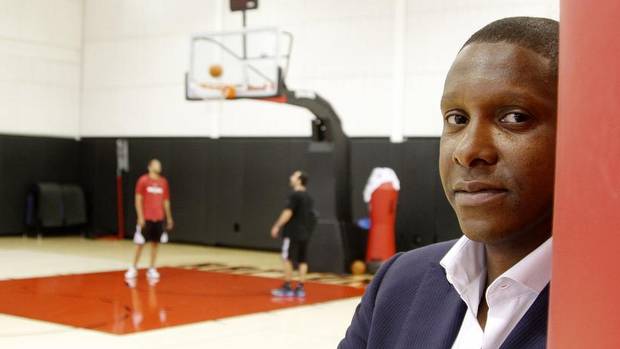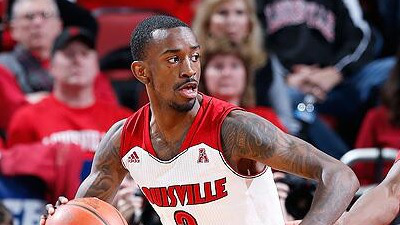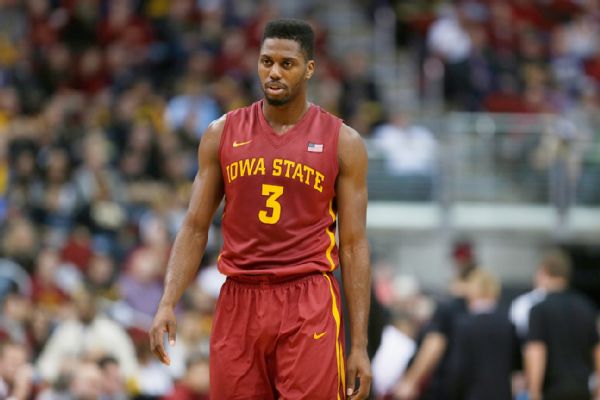There’s a lot of trade scenarios being bandied about these days, mostly due to boredom and all designed to figuring out a way to improve the roster so it can progress beyond an exciting, but ultimately lame, first round exit. DeMar DeRozan has usually been at the center of such discussion due to fans’ penchant for “selling high”, and when he’s not being hammered about on the ESPN trade machine, Terrence Ross is being thrown in the mix with deals involving Kevin Love and any other superstar than one can illogically fantasize about.
There’s also the 20th pick which in this year’s draft, if you ask some, is tantamount to possessing a sack of grain in a famine. Others value it only slightly more than an unsightly rash, making the spectrum of value for this pick wider than the gap between our t-shirt design team and MLSE’s. The pick is seen as a means of trading up through packing an player or two to go along with it, or even as a trade asset entirely on its own. The possibilities that fans can come up with are both creative and bizarre, making the whole enterprise rather entertaining if not bemusing.
What we haven’t contemplated much of is what if the Raptors stand pat and do nothing. They don’t make any big free-agent signings and focus only on retainment. They draft a player with the 20th pick who is intended to be used as a roster player next season. They rely on that ever-so-tempting organic growth to improve the team over the summer and come back with, more or less, the same roster sprinkled with some salt and pepper. What would happen then?
To find an answer to that question we’d have to more closely look at how much of a leap the current crop can make over one summer, and what it would mean in the context of the Eastern Conference. It would be fair to assume that Kyle Lowry would not be much better than he was last season, and if anything, is likely to average out a bit next year. Expecting him to exceed his 17.9 points and 7.4 assists per game for next season would be a tall order, and even if he does, it’s difficult to see him doing it by much.
Jonas Valanciunas, who is working with Hakeem Olajuwon this summer, could stand to improve by a large factor in his career, but how much of that will happen over one summer remains to be seen. Of all active centers who averaged 10 points, the biggest second to third year points jump that we’ve seen has been Marc Gasol’s 2.9 points, followed by Nikols Pekovic’s 2.4. Based on this, Valanciunas’ 11.3 points are likely to improve while remaining modest. Certainly, you don’t expect him to become a 20/10 player over the summer.
Viewing Terrence Ross through the same lens, we can see that wings are more able to make a jump in their third year. Kevin Martin’s 9.4 point and Andre Iguodala’s 5.9 point jump are just some of the examples of wing players finding a new gear in their third year to become more refined scorers. Terrence Ross, based on statistics at least, is more likely to produce at a higher rate next season than any other Raptor.
The eye-test would stand to confirm this as well as Ross possesses a great shot, good ball-handling skills, and has shown that he’s got the core tenets of a good offensive player. Even considering that the potential and likely outcome are often two different things, most fans can attest that Ross has, if appropriate improvements and coaching adjustments are made, a chance to contribute in a greater capacity next season. One doesn’t have to look too far south to Washington to see a comparable player in Bradley Beal progress so fast, and hope that Ross can ride the same type of wave.
Then there’s DeMar DeRozan, whose PER shot up by 3.7 points and whose ORTg went up to 110 for the first time since receiving meaningful minutes. If he improves by the same amount next season (taking him to 22.1), it wouldn’t (PER-wise) put him in the category of LeBron James or Chris Paul, but closer to guys like Russell Westbrook and James Harden, which in the context of the Raptors would be a commendable improvement in offensive production.
You can assume that Amir Johnson, injury aside, continues to produce the way he has and the subs do what they do. There’s of course the intangible element of chemistry which is hard to measure, predict, or repeat, so we’ll say it stays the same since the core group is the same. Add in a backup center which makes sure we see less of Chuck Hayes, and you start seeing the possibilities and limits of these Raptors next season. Much like the Raptors would be relying on continuity to be the underpinning driver of improvement, the same would be true for Charlotte, Washington and Atlanta. Whether the Raptors’ improvement will be greater than those teams is a question of debate, and the only surety is that just like how the playoff experience benefited the Raptors, it did so to those other clubs as well, even more so for Washington.
Assuming that all things stay even and the Raptors manage to hold the teams beneath them at bay next season, is there a chance for them to climb the ladder in the East by keeping the roster structurally similar? There was a six point gap between the Raptors and the Heat and an 8 game one between Indiana and Toronto. In reality the gap between Miami is likely more and the Pacer gap less. It would take a considerable drop from those two clubs and a marked improvement from Toronto to see them switch places with either. There’s a likely shake-up happening in Indiana with Roy Hibbert on the fringe and David West a year older, but at the same time it’s hard to see Larry Bird not converting his assets into value next season, thus maintaining Indiana’s relative superiority in the East. If the Big Three return, Miami will be where they always are. The gist here is that the Raptors will have strong competition from the north and a push from the south if they hope to retain their third place conference seeding.
As I see it, bringing back the same team, drafting a late-rotation center, and relying on continuity and chemistry is a start that will perhaps bring us a 3rd-5th seed next season, but doesn’t separate the Raptors from the pack nor does it do enough to catch the leaders. Individual player improvements are happening not just in Toronto but Washington, Charlotte, Atlanta, and Chicago, and unlike years past, the Raptors are in an Eastern Conference that is growing strong. In order for the Raptors to make the leap or at least create separation from the pack, they’ll need to address their weak points as displayed in the post-season.
John Salmons and Landry Fields are not sufficient cover at the small forward, the frontcourt rotation suffers from a lack of size and strength, and the bench doesn’t have the players that can play the type of defense Casey prefers. In the form of assets, Ujiri has his first-round draft pick, two in the second round, and expiring contracts in Landry Fields ($6.2M) and Chuck Hayes ($5.9M). John Salmons is sure to be waived prior to June 30th, thus reducing his cap hit to only $1M next season. Whichever way you slice and dice these assets, it’s very difficult to imagine the Raptors yielding something of great value by moving these pieces without throwing in a starter.
Far be it from me to speculate on particular trades so I’ll leave it at this: in order for the Raptors to improve and address multiple deficiencies, Ujiri will be very tempted to part with one of his key players. The Thunder remained competitive after trading away James Harden and the Clippers were the same after trading Eric Bledsoe (granted, for different reasons), and that was due to there being a critical mass of talent that could carry the team forward. The Raptors, as presently constructed, don’t appear to have that critical mass and if they roll the dice and trade a key player away without netting something substantial in return, they risk taking a step back more than forward. Such is the tricky nature of Masai Ujiri’s position, which is one where he can play it safe and rely on organic growth knowing that competition will be tough, or one where he can be aggressive and potentially ensure that the same competition remains at arm’s length.




